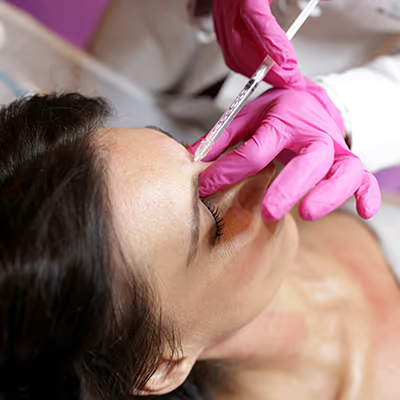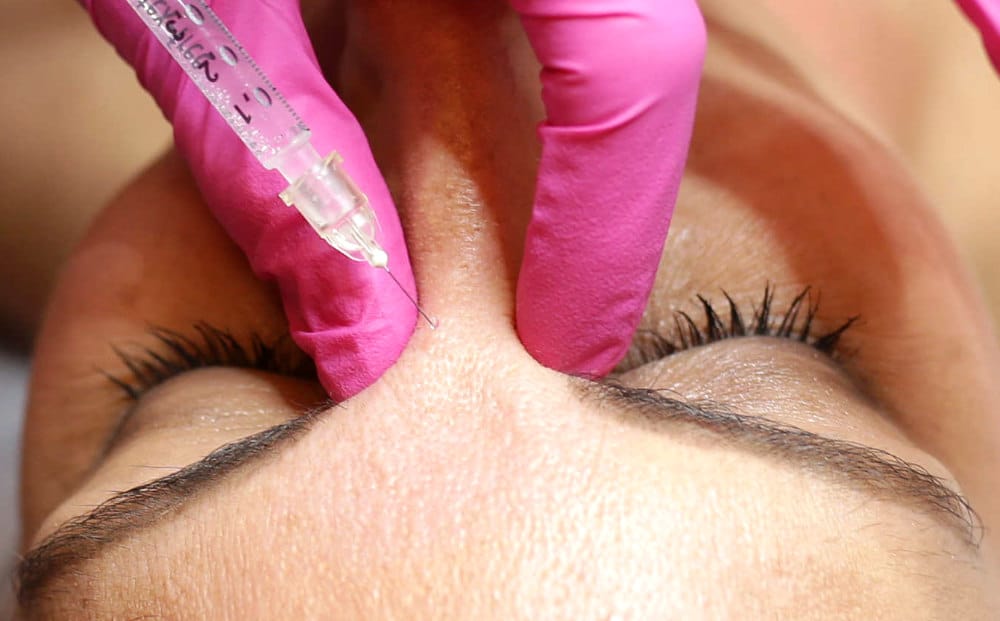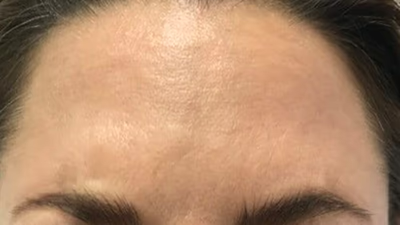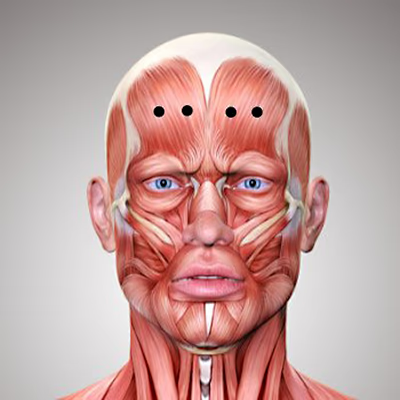Forehead Botox Treatment at a Glance
- Botox is a neuromodulator that relaxes the forehead muscles, helping to smooth horizontal lines and wrinkles.
- Because the body naturally breaks down Botox over time, its effect is temporary, typically lasting 4 to 6 months. After that, the treatment can be repeated to maintain results.
- No anesthesia is required for Botox injections in the forehead.
- Common side effects include mild redness, swelling, or bruising, which usually resolve within 2 to 3 days.
- There is no downtime—you can resume normal activities immediately after treatment.
- The procedure takes about 30–45 minutes for the initial visit and 10–20 minutes for follow-up sessions.
Table of Contents:
- Smoothing Forehead Lines – When and How Much?
- My Approach: Dynamic Forehead Rejuvenation
- Smooth Forehead Without Drooping Brows (Ptosis)
- Who Is a Good Candidate for Forehead Botox?
- Who Should Avoid the Treatment?
- Treatment Procedure
- Results and Longevity
- Risks and Possible Side Effects
- Cost of Forehead Botox Treatment
- Frequently Asked Questions (FAQ)
- Why Choose Dr. Strobl for Forehead Botox in Munich?

Smoothing Forehead Lines – When and How Much?
Botox for the Forehead – A Classic Treatment
Treating forehead lines with Botox is one of the most established uses of the neuromodulator. While it may seem simple, forehead smoothing requires skill and nuance—because forehead lines also play a positive role in expression. They appear when we listen attentively or show interest. By raising our brows, we convey engagement and empathy, making forehead movement an important part of our emotional communication.
Smoothing Forehead Lines Without Losing Expression
Authenticity comes from the harmony between what we say and what our face communicates. When someone expresses concern, we expect to see a slight furrow in the brow. If it’s completely absent, the expression can appear insincere or detached.
When Do Forehead Lines Become a Problem?
The positive effect fades when forehead lines become deep and permanent, making a person look stern, tired, or worried. Deep creases across the forehead can give the impression of skepticism or disapproval, even when none is intended.
Particularly striking is the frown line between the eyebrows. A pronounced frown line can strongly affect how others perceive you—and how you feel about yourself. Research on Botox for mood improvement and depression often focuses on these forehead and frown line treatments, highlighting their impact on both appearance and emotional well-being.
Treatment Procedure
- Personal Consultation
Every forehead Botox treatment begins with a detailed consultation at my Munich practice. I analyze your facial expressions, wrinkle pattern, and muscle activity to determine the exact dosage and injection points. The goal is a natural-looking result that preserves your individual expressiveness—without creating a frozen “Botox forehead.” - Skin Preparation
Before smoothing forehead lines with Botox, the skin is thoroughly cleansed and disinfected. A numbing cream can be applied on request, though it is rarely needed, as the fine needles used make the injections virtually painless. - Precise Injection of Botulinum Toxin
Botulinum toxin type A (Botox) is injected precisely into the forehead muscles using a micro-fine needle to relax dynamic lines and smooth the skin. The treatment takes about 10–20 minutes, is performed on an outpatient basis, and requires no anesthesia. Any mild redness typically fades within a short time. - Immediate Aftercare
After the forehead Botox treatment, the skin may be slightly red or sensitive. Cooling helps soothe the area. For about 24 hours, you should avoid exercise, sauna, and tanning, to prevent unwanted diffusion of the product. - Follow-Up and Adjustment
The effect of Botox becomes noticeable after 2–5 days and reaches its full result within about two weeks. A follow-up visit after 10–14 days allows me to review the outcome and, if necessary, perform a minor touch-up—ensuring a smooth, natural, and harmonious forehead.
Results and Longevity
Die Wirkung von Botox zeigt sich nach wenigen Tagen und ist nach etwa zwei Wochen vollständig sichtbar. Die Stirnmuskeln entspannen sich, die Falten glätten sich, und der Gesichtsausdruck wirkt frischer und entspannter.
Das Ergebnis hält im Schnitt 4 bis 6 Monate an. Bei regelmäßiger Auffrischung verlängert sich die Wirkung, da sich die Muskulatur zunehmend beruhigt. Wenn der Effekt nachlässt, kehren die Falten allmählich zurück, bleiben aber meist weniger ausgeprägt.
Langfristig trägt die Behandlung dazu bei, neue Stirnfalten zu verhindern und ein natürlich glattes Erscheinungsbild zu bewahren.
Risks and Possible Side Effects
Botox for the forehead is considered safe and well tolerated when performed by a qualified practitioner. However, as with any injection, temporary side effects can occur:
- Mild redness, swelling, or small bruises at the injection site
- Temporary headache or a mild pressure sensation in the forehead
- Asymmetry in forehead movement due to uneven muscle response
- “Spock brow” (overly lifted outer brow) if the lateral area is under-treated
- Brow ptosis (slightly drooping brows) if injected too deeply or too low
- Rare: temporary blurred vision from product diffusion
- Very rare: allergic reactions or hypersensitivity
These effects are temporary and usually resolve within a few days to weeks. Using a precise injection technique and carefully adjusted dosing helps prevent such undesired outcomes.
Cost of Forehead Botox Treatment
As a guideline, the cost of Botox for forehead treatment at my Munich practice ranges from €280 to €385. This includes a full vial containing 50 units of botulinum toxin (Vistabel) —usually sufficient to treat the forehead, glabella, and brows in a single session.
For Micro-Botox treatments, it can be more cost-effective to combine several treatment areas, making full use of an opened vial. In such cases, the average cost per unit is approximately €6–8. Further details can be found on my dedicated page about Botox pricing.
Please note: The final fee for any Botox treatment is billed according to the German Medical Fee Schedule (GOÄ) and may vary based on the amount of product used. Botox for the forehead is considered an aesthetic procedure, and costs are not covered by public or private health insurance.
FAQ – Botox Forehead Treatment
No, Botox doesn’t work for all types of forehead lines. The best results are seen in patients who can voluntarily contract and relax their forehead, causing the horizontal lines to appear and disappear. However, if the forehead lines are visible even at rest due to a constantly high muscle tone, Botox alone may not produce a fully satisfying result.
No. Botox does not work on sleep or static wrinkles, as these vertically oriented lines are not caused by muscle activity. They develop from repeated skin compression during sleep, especially when lying on one side for extended periods.
The most common result of too much Botox in the forehead is drooping eyebrows. If it occurs on only one side, one brow will sit higher than the other—a condition known medically as brow ptosis. While it may look uneven, it usually resolves on its own within a few weeks.
To help speed recovery, you can gently massage the area around the eyes with your fingertips or the back of an electric toothbrush. In some cases, Apraclonidine eye drops (Iopidine 5 mg/ml) may be prescribed to temporarily lift the upper eyelid and improve symmetry until the Botox effect fades.
A good alternative to traditional forehead Botox is Baby Botox, as mentioned above. In this technique, the product is more diluted and injected into the skin rather than the muscle, allowing full facial expression to remain intact.
In cases where forehead lines are not caused by muscle movement or when increased muscle tone limits the effect of Botox, other options may be more suitable—such as hyaluronic acid fillers, a PDO thread lift, or laser resurfacing treatments.
Yes, Botox for the forehead can safely be performed in summer. Claims that heat or sunlight make Botox break down faster—or that it might be harmful—are unfounded. In fact, summer is often an ideal time for treatment. Bright sunlight causes us to squint more frequently, which promotes the formation of expression lines. By relaxing the involved muscles, Botox helps reduce this repetitive movement and prevents new sun-related wrinkles from forming.

About the Author:
Dr. med. univ. Eva Maria Strobl is the owner of LIPS and SKIN Aesthetic Medicine practice in Munich. She is a trained specialist in general medicine (MedUni Vienna) and has over 10 years of specialization in non-surgical aesthetic procedures. Dr. Strobl is a member of the German Society for Aesthetic Botulinum Therapy e.V. (DGBT), the German Society of Anti-Aging Medicine e.V. (GSAAM) and of Network Global Health. She publishes regularly on her blog and on DocCheck.




